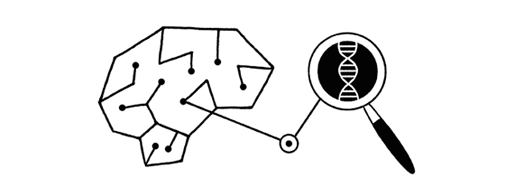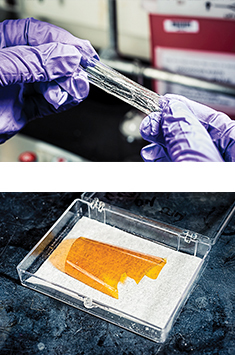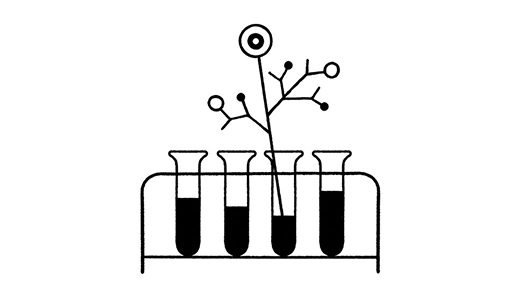Aaswath Raman
Your next air-conditioning system might save energy by beaming heat into outer space.
Aaswath Raman holds a thin, silvery disc. It looks like a very clean mirror, but it’s hardly ordinary: it gets colder under direct sunlight and stays about 5 °C cooler than the surrounding air.
Raman is a practical person with a gentle personality; his button-down shirt and flip-flops blend in on the campus of Stanford, where he is a postdoctoral researcher. This mirror, he calmly explains, has a coating that sends heat into the vastness of outer space—which could make it ideal for air-conditioning and refrigeration systems that would require very little or no electricity.
The cooling material takes advantage of a fascinating phenomenon. Objects are always cooling down by radiating heat—this is why dew forms on blades of grass at night. Some of the radiation occurs at frequencies that send the energy right through Earth’s atmosphere and into space, allowing the object’s temperature to drop below that of the surrounding air.
During the day, the sun’s heat usually overwhelms the cooling effect. But while reading through old papers on the subject from the 1960s, Raman thought of a way around that. He applied his knowledge of nanoscale manufacturing techniques that didn’t exist decades ago to make something with optimum levels of thermal radiation and solar reflection. It is a multilayered film of hafnium dioxide, silica, and other materials deposited at carefully controlled thicknesses. It can be made over large areas using the same manufacturing techniques that are used to coat windows.
Coating the roof of a small structure with some of his material would wick heat away and keep the inside cool without electricity, as long as the roof wasn’t insulated. Since most buildings in developed areas have insulated roofs, Raman is working on integrating the material into existing air-conditioning infrastructure. He has a prototype on the roof of Stanford’s Packard Electrical Engineering Building. It is made up of a sheet of the passive cooling material about a square meter in area, mounted in a custom-machined plexiglass box patterned with water channels. In a finished system, the water would circulate through the building air-conditioning system, then go into the cooler box to chill and back into the building system. However, he still needs to demonstrate that his prototype can chill a substantial volume of water.
He has already partnered with a manufacturer that can produce large sheets of the cooling material for further development. He jokes that many researchers in his branch of physics tend to stay in their labs all day and “don’t like to go outside.” But he adds: “If you just go outside, there’s opportunity.”
—Katherine Bourzac
Watch this Innovator at EmTech 2015
Meet the Innovators Under 35
Polina Anikeeva
A creative scientist sees new ways to record and stimulate brain activity.
“For my PhD at MIT, I worked on quantum-dot LEDs, and having zero biological experience, I chose to spend two years in Karl Deisseroth’s neuroscience lab at Stanford. When I saw that they were developing methods to control the brain optically and investigate brain function, I was really blown away. [But] the tools we were using were too large and too bulky, and didn’t have enough capability. Since my background was nano–optoelectronics and nanofabrication, I felt that we should be able to do better. That became the foundation of my lab [at MIT].
The lab is divided into two main directions. One is using fiber fabrication to create neural probes that have multiple functions. The other is to figure out if we can interact with the nervous system in an essentially wireless and noninvasive way.
Ultimately, you want to figure out how specific patterns of neural activity correspond to specific behaviors. What we’re trying to do is push the resolution of our recording and stimulation capability, which will allow us to decipher those neural circuits. If you’re trying to, say, restore function after spinal-cord injury, if we were able to record signals from both sides [of the injury] and convert them into patterns of stimulation, we would be able to start building a synthetic bridge across that connection. Right now, we would love to work with people and get this technology into as many labs as we can.”
—as told to Courtney Humphries
Watch this Innovator at EmTech 2015
Meet the Innovators Under 35
Gozde Durmus
It’s amazing what you can learn about a cell when you levitate it.
Cells that are dying, turning cancerous, or responding to drugs undergo physical changes. They might become stiffer or squishier. Or they might get heavier or lighter. The instruments for detecting these changes in individual cells are usually complex and expensive, which is why microbiologists still assess the state of a disease by waiting for cells to grow in a lab, and why doctors examine whether a drug is working by waiting to see whether the patient worsens or improves.
Gozde Durmus has invented a simple, fast method for detecting cells’ telling physical characteristic: making them levitate in a magnetic field and measuring how high they rise. White blood cells, red blood cells, cancer cells, and different bacteria each rise to a different height, because they have a characteristic density that determines the balance between the pull of gravity on the cell and the push of the magnetism. And Durmus has found that when a bacterial cell has responded to an antibiotic, it tends not to rise as high in the magnetic field as it did before. This change can be detected in about an hour, instead of the day traditionally required to determine how a microbe responds to a drug.
At her bench at the Stanford Genome Technology Center, Durmus makes cell-levitating devices by sliding a few laser-cut pieces of plastic over two small bar magnets. This keeps them from flipping and sticking together, so a magnetic field can be created in the space between them. She puts a thin capillary tube into that space. Then she adds two mirrors that will beam an image of the tube up to a conventional microscope. Samples of the cells to be levitated go into the tube along with a solution of gadolinium, an element that’s used as an MRI contrast agent. “It helps the cells fly in the magnetic field,” says Durmus. Their height can then be measured under the microscope.
Durmus knows from experience how important rapid, personalized drug monitoring could be. When she was a child in İzmir, Turkey, she had a bacterial infection that lasted three years, and she vividly remembers going to the hospital for painful and ineffective penicillin shots until she got the right treatment.
Her work also has a more whimsical inspiration. In 1997, physicists in the Netherlands used an ultrastrong magnet to levitate a living frog. Subsequent efforts to levitate things in weak magnetic fields—even objects much smaller than frogs—required toxic magnetic solvents. Durmus figured out how to do levitation without toxic materials, using only cheap magnets and some pieces of plastic.
—Katherine Bourzac
Watch this Innovator at EmTech 2015
Meet the Innovators Under 35
Gilad Evrony
Single-neuron genome sequencing is revealing clues about what goes wrong in the brain.
From studying 300 neurons one at a time, Harvard Medical School researcher Gilad Evrony helped make a surprising discovery: brain cells sitting right next to each other don’t always have the same genetic codes. This could provide insight into age-related cognitive decline and brain disorders such as epilepsy and schizophrenia.
When scientists sequence DNA, they typically examine genetic material from thousands or millions of cells at a time. Decoding the genome of an individual cell is more challenging. Although researchers had done it with cells from other parts of the body, Evrony developed a way to do it with neurons from cadavers. Then he painstakingly mapped the origins of the mutations he found.
The implications are remarkable. For one thing, finding out the precise location of mutations indicates that some mental disorders can be traced back to just a few bad neurons. Crucially, such mutations apparently are not inherited; they crop up in brain cells during development or over our lifetimes—and accumulate as we age. The rate at which those errors occur is not clear, though, and figuring that out could help explain how cognitive decline sets in and how it might be staved off.
Such insights appear to be just the beginning of what we might discover by analyzing individual neurons. The National Institutes of Health has organized a consortium of labs that will study several mental disorders using this method, among others. Evrony calls the technology “the brain’s new microscope.”
—Julia Sklar
This story was updated on August 21 to clarify the nature of the mutations.

Watch this Innovator at EmTech 2015
Meet the Innovators Under 35
Jeannette Garcia
A chance discovery sparked a quest for plastics that are both strong and recyclable.
If Jeannette “Jamie” Garcia hadn’t been so obsessed with understanding what things are made of, she probably would have “red-canned” her big discovery—that is, tossed it in the trash.

Bottom: A sample of her super-strong yet recyclable plastic.
It was the young chemist’s first week at IBM, and she had a simple task: mix three ingredients together in a flask and heat them up, the goal being to use one of those ingredients—a solution made from broken-down plastic bottles—as the basis for an even stronger material. After she combined the first two ingredients, she went off to weigh out the third. By the time she got back, the solution had solidified into something so hard that she needed a hammer to break it free. “A lot of people would’ve considered it a failed experiment,” Garcia says. But she adds: “I didn’t really want to just drop it. I wanted to try to figure out what I had made.”
It turned out that the plastic was not only much stronger than what she had originally been trying to make but entirely recyclable. Those properties made it a promising gateway to desirable new materials.
Plastics that harden when heated are nothing new; we use them in everything from electronics to airplanes. But these so-called thermosets are not remoldable once hardened and mostly end up as garbage because they are very difficult to recycle. The thermoset plastic that Garcia made, on the other hand, completely reverted to its base compound, or monomer, when soaked in acid. “As chemists,” she says, “if we understand what we’re doing well enough, then we can actually go in and undo it too, in just as efficient a way as we built it.”
Now, with the right monomers and the right temperatures, Garcia can make both super-strong recyclable plastics and moldable gels that solidify in their desired shape under ultraviolet light. She has nicknamed the first class of materials Titan and the second one Hydro.
There’s still work to do before they are ready for commercial applications. But now that we know recyclable thermosets are possible, Garcia says, we can think of how they might replace materials we’ve been using for decades.
—Suzanne Jacobs
Watch this Innovator at EmTech 2015
Meet the Innovators Under 35
Jun Ge
Why we might use tiny flowers, trees, and spindles to create the pharmaceuticals of the future.
Manufacturing pharmaceuticals is typically a messy business. Catalyzing the necessary chemical reactions often requires toxic solvents and large amounts of energy. Jun Ge hopes to clean up the process substantially by instead harnessing enzymes, nature’s catalysts, to do the work.
Lots of people have had that idea. The challenge is that enzymes tend not to hold up well in industrial processes, and protecting them by attaching them to other materials greatly lessens their activity level. But Ge, a slender and soft-spoken chemical engineer at China’s elite Tsinghua University, had an insight a few years ago. While working as a postdoc at Stanford, he had a hunch that adding copper ions to a solution containing a certain enzyme could help activate and stabilize it. What he didn’t expect to find were the wondrously strange structures that soon precipitated at the bottom of his test tube: “very beautiful structures, like flowers made of protein and crystal.” Significantly, the enzymes held in this extraordinary “nano-flower” shape are stable and seven times more active than when they float freely in a solution. The findings made the cover of Nature Nanotechnology in 2012.
Today Ge is studying a range of enzyme nanostructures—which he dubs “nano-trees” and “nano-spindles”—and exploring whether they could be used in everything from the production of a cancer drug to a next-generation glucose strip for diagnosing diabetes.
—Christina Larson

Zhen Gu
Diabetics are tired of sticking themselves with needles. Someday they may not have to.
Problem:
People with diabetes must monitor their blood sugar and inject themselves with insulin several times a day. Even those with insulin pumps risk complications from injecting too much or too little insulin.
Solution:
Zhen Gu, a researcher at the University of North Carolina and North Carolina State University whose grandmother died from diabetes complications, is developing insulin delivery mechanisms that could be better. The most recent one is a fingernail-size patch covered in more than 100 microneedles. When you put the patch on your skin, you feel momentary pinpricks as the needles poke into your blood vessels. The needles are full of tiny sacs containing insulin and an enzyme. The sac is just permeable enough to allow glucose inside, where the enzyme converts it to an acid that—when blood sugar is too high—makes the sac open and release the insulin. The sacs fall apart at different rates, so the insulin is released over hours rather than in one burst.
When Gu tested the patch on five mice, it controlled their blood sugar for nine hours, although it takes half an hour to work, and people without diabetes naturally regulate their blood sugar much faster than that. Now he has begun testing the patch on pigs, whose thin skin is more similar to humans’. Eventually, Gu hopes, people with diabetes could slap on a patch every two or three days to reliably and precisely control blood sugar without much pain or effort.
—Anna Nowogrodzki
Watch this Innovator at EmTech 2015
Meet the Innovators Under 35
Elizabeth Mormino
A telltale protein seen in people’s brains before they have Alzheimer’s could offer a clue about possible treatments.
Elizabeth Mormino knows it’s too late to save her grandfather, whose Alzheimer’s disease was diagnosed a few years ago. “It’s really hard to see a familiar face go through this, knowing that there’s really no drugs that work right now,” she says. But her work may help future patients by showing an intriguing new path to treating the disease.
Mormino has figured out a way to combine two imaging technologies to detect the protein beta-amyloid, which is found in patients with Alzheimer’s, and has used them to look at the brains of people with no signs of cognitive decline. Although researchers have already been using one of the imaging technologies, called PIB-PET, to see beta-amyloid in the brains of living patients for a few years, Mormino is able to identify brain regions more accurately by combining PIB-PET and MRI data.
“I feel like we’re taking snapshots of people’s brains,” she says. “It feels very personal and intimate.”

The most surprising insight from her work is that some outwardly normal people are “walking around with a head full of amyloid, and oftentimes as much amyloid as somebody who actually has clinical Alzheimer’s disease,” she says.
How could this be? One hypothesis is that amyloid causes neurons to die, which then causes the clinical symptoms of Alzheimer’s. So by the time patients have Alzheimer’s, anti-amyloid treatment is too late—the protein has already damaged too many brain cells. (Indeed, anti-amyloid drugs have not proved effective at treating Alzheimer’s.) But some of her healthy patients could have protective factors, whether in their genes or in their lifestyle, that allow them to tolerate high amyloid levels without developing Alzheimer’s.
Understanding such protective factors might “offer some insights into successful aging or the ability to remain resilient,” says Mormino. And there is a chance it could help specifically with Alzheimer’s prevention. To that end, researchers at the University of California, San Diego, and Massachusetts General Hospital, where Mormino is an assistant in neuroscience, have started clinical trials in which people who have high amyloid levels but no Alzheimer’s symptoms are getting anti-amyloid infusions to see if that staves off the disease.
The hope is that eventually Alzheimer’s could be prevented by regularly checking and treating amyloid levels, much the way heart attacks are averted by monitoring cholesterol.
—Anna Nowogrodzki
Michelle O’Malley
Understanding a tricky kind of single-cell creature could help reduce the cost of biofuels.
Chemical engineer Michelle O’Malley is trying to figure out how an understudied type of microbe could be harnessed to make better biofuels or pharmaceuticals. O’Malley works with anaerobic microbes—organisms that can’t live in the presence of oxygen, making them extremely difficult to cultivate. In fact, her lab at the University of California, Santa Barbara, is the only one in the United States that is able to study the behavior of anaerobic microbial communities.
Why go to all the trouble? Because these organisms are more efficient than aerobic ones at chewing up plant material and secreting something else, like a biofuel. They also create fewer unintended by-products, which are costly to deal with.
O’Malley is particularly interested in how different kinds of anaerobic microbes function in concert. Sometimes in such communities, whether in landfills or our guts, microbes work together to attack substances in their midst, while other times they interact peacefully with their environment. Their behavior, it seems, is determined by a complex communication system: microbes can physically attach to each other and exchange nutrients, or they can secrete chemicals into the environment that another microbe can metabolize.
Understanding this process is the first step in getting anaerobic microbes to churn out more cost-effective fuels or pharmaceutical products—and things we can’t yet imagine. After all, O’Malley explains, many of the enzymes produced in anaerobic microbe communities “perform chemistries never seen before.”
—Julia Sklar
Watch this Innovator at EmTech 2015
Meet the Innovators Under 35